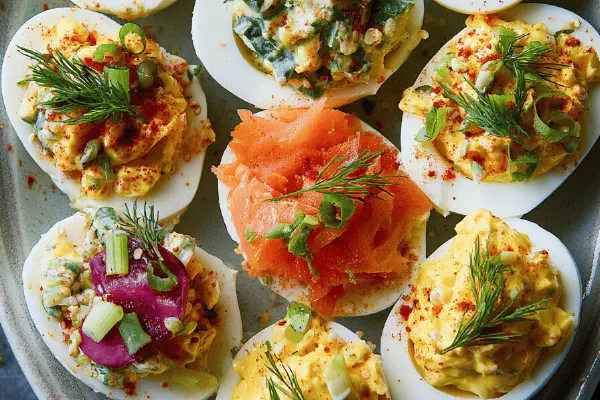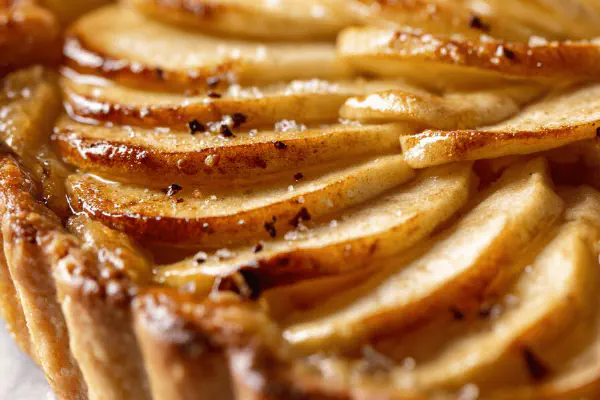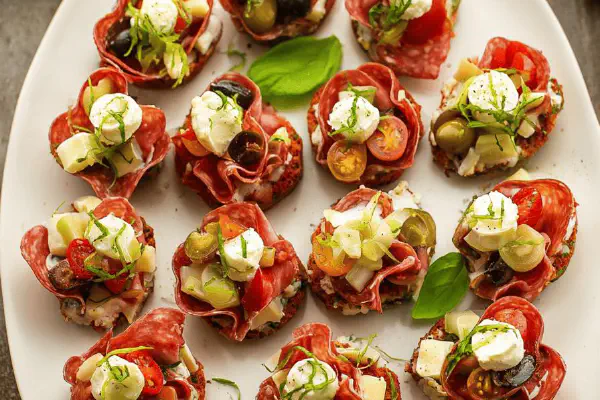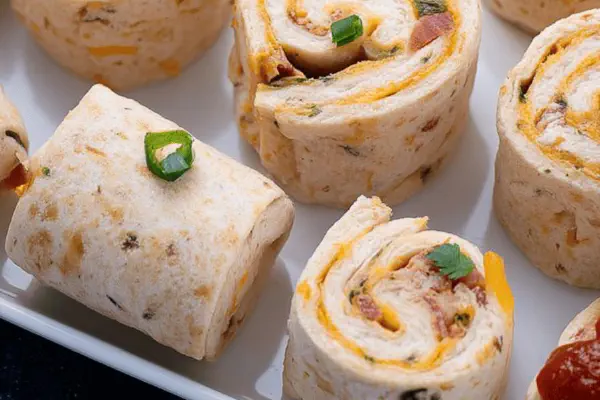Mini Pork Tourtières
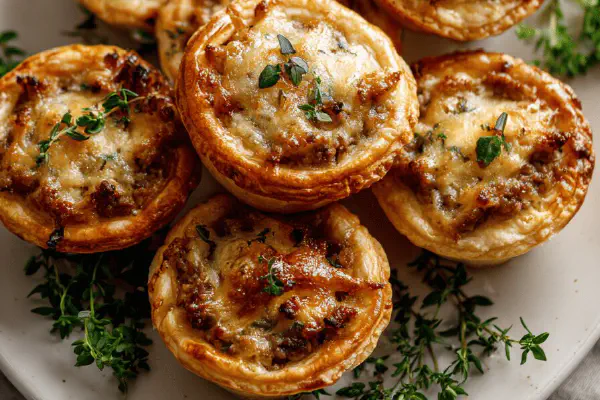
By Emma
Certified Culinary Professional
Ingredients
Pastry
- 342 g (2 7/8 cups) all-purpose flour
- 8 ml (1 3/4 tsp) baking powder
- 205 g (7 oz) cold unsalted butter, cubed
- 1 egg, beaten
- 55 ml (3 1/2 tbsp) iced water approx
- 20 ml (4 tsp) apple cider vinegar
Glaze
- 120 ml (1/2 cup) whole milk
- 1 egg
Filling
- 2 medium onions, finely chopped
- 1 clove garlic, minced
- 30 ml (2 tbsp) olive oil
- 75 g (1/2 cup) mushrooms, finely chopped
- 450 g (1 lb) ground veal (or ground pork as substitute)
- 1 ml (1/4 tsp) ground clove
- 2.5 ml (1/2 tsp) dried savory
- Salt and freshly ground black pepper to taste
About the ingredients
Method
Pastry
- 1. Pulse flour and baking powder briefly in food processor. Add cold cubed butter. Pulse short bursts until coarse crumbs appear, about pea-sized lumps mixed with flour. Don’t overdo or butter melts. Add beaten egg, iced water gradually, and vinegar. Pulse a few times until dough just starts to gather. Avoid overmixing; you want crumbly but coming together. Scrape out. Form into disk. Wrap tight in plastic. Chill 50-60 minutes. Rest lets gluten relax and butter firm for flakiness.
Glaze
- 2. Whisk whole milk and egg in small bowl for glossy brush later. Keep in fridge until assembly.
Filling
- 3. Heat olive oil in skillet medium-high. The sizzle is first sign. Add onions and garlic. Stir often, cooking until softened and lightly golden, about 6-7 minutes. Don’t rush, let sugars develop deep aroma. Toss chopped mushrooms in. Stir until moisture evaporates and mixture smells earthy, around 4 minutes. Increase heat slightly.
- 4. Crumble ground veal into pan. Break apart with spatula, brown until no pink remains, about 8-9 minutes. Season with salt, pepper, clove, and savory. Try a pinch and adjust—clammy meat means undercooked or excess liquid. Cook until mixture looks crumbly and browned. Transfer to bowl and let cool before mixing in.
Assembly and Baking
- 5. Heat oven to 175 °C (350 °F). Place rack low in oven to crisp bottom crust.
- 6. On floured surface, divide dough in half. Roll first half 3 mm thick. Using 12.5 cm (5 in) cutter, stamp out 12 circles. Press each into greased muffin tin cups making shells. Repeat with second half.
- 7. Spoon cooled filling evenly into shells. Don’t overfill or risk bursting.
- 8. Roll remaining dough 3 mm thick. Cut 12 smaller lids (9 cm / 3 1/2 in). Place over each pie. Seal edges firmly by pressing with fingers or fork rim. Trim excess dough if needed. Brush edges with glaze to act like glue. Prick small vents in each top for steam escape, using tip of knife or skewer.
- 9. Brush entire tops with glaze for golden shine.
- 10. Bake 42-48 minutes. Watch crust color—should be deeply golden brown, crisp to touch, no doughy spots. Internal filling springs back lightly when poked. If tops brown too fast, tent loosely with foil.
- 11. Remove from tin immediately after baking to avoid soggy bottoms. Let cool slightly before unmolding. Serve warm but not piping hot; flavors bloom when just cooled.
Tips and Tricks
- - Using veal adds softness but ground pork works well too. Avoid lean turkey; dries quickly.
- - If dough cracks when rolling, rest longer or add splash more iced water sparingly.
- - Recipe scaled slightly down flour and butter after many trial batches to avoid greasy crust.
- - Substitute olive oil in filling with butter if you want deeper richness.
- - For visual twist, sprinkle crushed fennel seeds on top before baking.
Cooking tips
Chef's notes
- 💡 Keep butter cold. Cubed ice-cold butter pulses with flour, creates flaky pockets. Warm butter equals greasy, flat crust. Use short pulses; watch crumbs shape—small pea lumps, not paste. Overmix and dough turns tough. Rest dough wrapped and chilled at least 50 mins ; relax gluten, firm butter. This breaks stubborn dough stretch; helps layering, crisp curls. Rolling quickly with flour dust, not too heavy, stop at 3 mm. Thickness keeps pastry delicate, not chewy. Always tuck and chill excess dough. Repeat if dough warms or softens mid-shape.
- 💡 Watch sauté onions. Medium-high heat, add olive oil till sizzle signals right temp. Stir often; color should lighten slowly, tender golden, not burnt. Take 6-7 mins max. Mushrooms tossed in only after onions soften fully; stir till moisture evaporates. Too wet filling ruins crust bottom; sogginess lurks. Mushrooms earthy scent tells when ready around 4 mins. Temperature bump after moisture mostly gone avoids overcooking. Brown meat separately; break up clumps with spatula early. Pink remnants mean longer cook needed. Season late, test flavor with tiny pinch; too salty masks clove subtlety.
- 💡 Glaze mix is simple but crucial. Whisk milk and egg vigorously; sets glossy finish seal. Keep chilled till ready. Brush edges before lids for glue effect; prevents spills. Prick vents with needle or tip knife in top lid vents pressure, avoids pie burst. Trim edges precisely to avoid dough folds that trap steam unevenly. Bake rack should be low in oven ; crisp bottom forms slowly. If tops color premature brown, tent foil loosely, keep oven heat even. Remove pie immediately from tin after baking, lets bottom stay crisp, stops soggy trap. Cooling slightly firms filling, stops hot drip. Reheat low and uncovered revives crunch; no microwave shortcuts here.
- 💡 Substitutions wise: ground veal shifts textural softening. Pork fattier, more punch but dry turkey no good; too lean, filling drier faster. Olive oil lends faint fruit notes; sub with butter richer but must cut dough chilling time; butter melts sooner. Vinegar in dough optimizes gluten strands; apple cider less sharp than lemon juice tried twice. Baking powder inflates texture differently from traditional shortening; tried both, baking powder adds lift without grease overload. Mushrooms fine diced soak flavors; not replacing with water-rich veg unless moisture managed strictly.
- 💡 Cooking sounds matter. Sizzle starts fill pan heat; trust early heat cues before addition. Stirring till onions turn golden signals sugar caramelizing deeper aroma awakening. Meat browning clink and faint hiss, no pink spots; smell changes to nutty, savory. Dough handling quiet but crisp when chilled right. Dough cracks on roll? Rest longer, add iced water teaspoon by teaspoon but cautiously; too wet dulls flakiness. Using a small sharp cutter for lids avoids stretch tears. Seal edges firmly finger press or fork rim to avoid leak. Bake timing variable; watch pie top color, tap lightly, bottom crust feel. Internal filling springs back slightly when poke done.
- 💡 Taste layering never skip. Clove used sparingly; too much overpowers. Savory dried leaves subtle umami, luckily flexible on amounts. Salt cautiously balanced; too little bland, too much overpower. Testing spoonful before final assembly saves after bake regrets. Frozen unbaked pies solid frozen store well; thaw in fridge overnight before bake. Reheat gently low oven to restore texture. Avoid microwave; crust soggy disaster. Crisp domed tops and juicy interior; listen for slight crunch bite, smell roasted aromas in air. Apple cider vinegar added subtle tang and tender crumb; skipped lemon due to sharp notes overpowering dough.
Common questions
How to keep crust flaky?
Cold butter key. Keep cubed well chilled. Pulse dough short bits in food processor, not overworked. Chill at least 50 mins wrapped tight for gluten relax. Add iced water slowly; too wet dough sticky, tough. Rest helps butter firm up again. Roll out quickly with flour dust; cracks fix with rest or water splash. Avoid warm hands; keep cool kitchen if possible.
Can I swap veal in filling?
Use pork more common; fattier; fills juicy. Veal softer texture, less heavy. Turkey leaner but dries fast; not ideal. Mushrooms amplify moisture control; omit if too wet. Butter or olive oil change flavor tones; butter richer, olive oil fruity. Adjust seasoning afterward; clove subtle. Test small pan spoon taste before filling pies. Flavor balance delicate but flexible.
What if filling too wet?
Cook mushrooms fully till moisture evaporates. Brown meat thoroughly; breaks clumping holds moisture back. Overcrowding pan traps liquid; cook batches if needed. Season late to avoid drawing out water too early. Soggy filling makes bottom dough limp, uneven bake. Let filling cool before assembling; warm filling melts crust prematurely. Correct liquid content key for crisp shell, mosaic textures.
Can I store and reheat pies?
Freeze unbaked pies wrapped airtight; thaw refrig overnight before baking. Baked pies last 2-3 days in fridge wrapped. Reheat low oven uncovered; restores shine, crisp edges. Avoid microwave; ruins crust texture, soggy underside. Leftovers reheat slow and steady best. Make ahead, freeze raw, bake fresh for best experience. Cooling after bake firms filling; reheating reactivates aroma and crunch.
